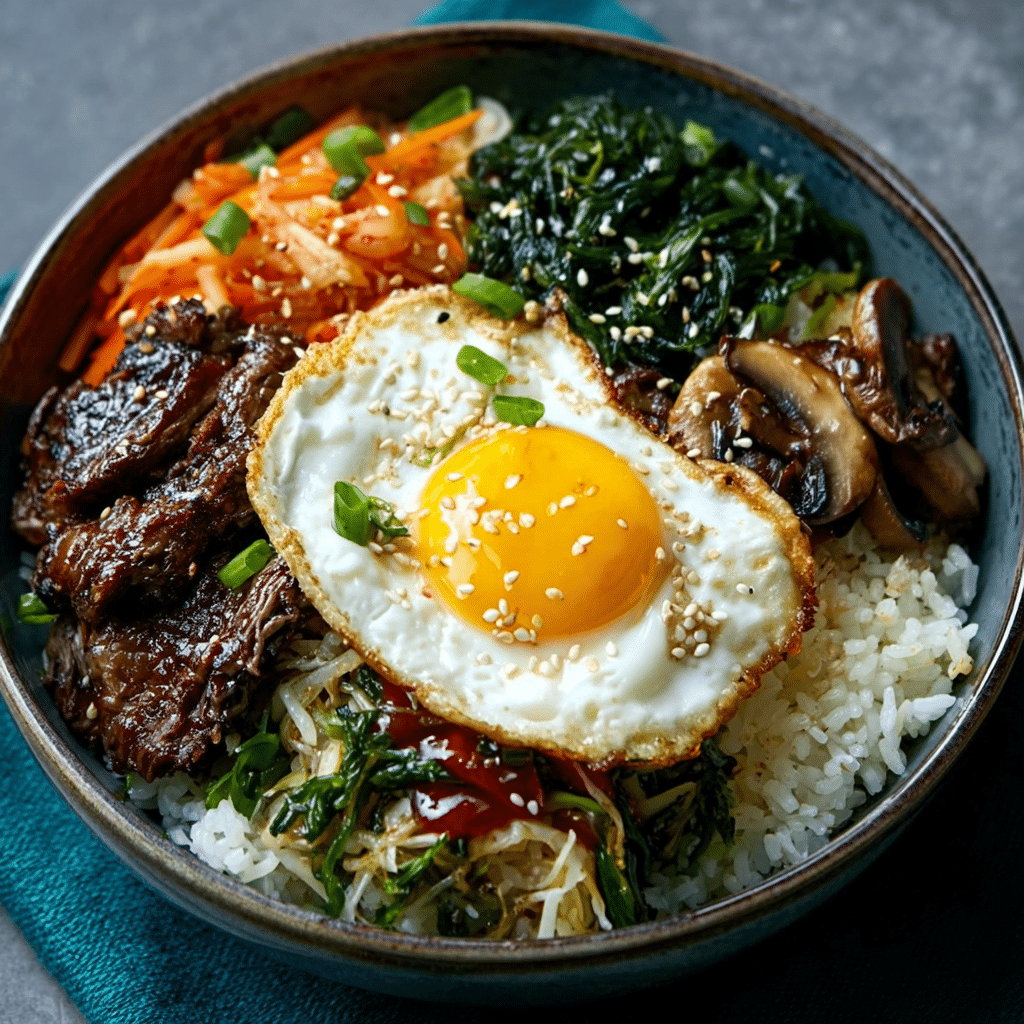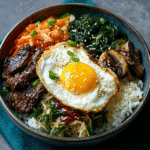gutenberg
Introduction to Korean Seaweed Bibimbap Bowls
Hey there, fellow food lovers! If you’re anything like me, juggling a busy life while trying to whip up something delicious can feel like a high-wire act. That’s where these Korean Seaweed Bibimbap Bowls come in—a delightful, colorful dish that’s not only quick to prepare but also packed with flavor and nutrition. Imagine a bowl brimming with vibrant veggies, fluffy rice, and a perfectly fried egg, all drizzled with sesame oil. It’s a meal that’s sure to impress your loved ones while making your weeknight dinners a breeze!
Why You’ll Love This Korean Seaweed Bibimbap Bowls
Let’s be honest—life can get hectic, and finding time to cook can feel like a luxury. That’s why I adore these Korean Seaweed Bibimbap Bowls. They’re not just quick to whip up; they’re also a feast for the eyes and the taste buds! With fresh ingredients and a delightful mix of textures, you’ll savor every bite. Plus, they’re versatile enough to please even the pickiest eaters in your family!
Ingredients for Korean Seaweed Bibimbap Bowls
Now, let’s dive into the colorful world of ingredients that make these Korean Seaweed Bibimbap Bowls a delightful experience! Each component adds its own unique flavor and texture, creating a symphony of tastes in every bite. Here’s what you’ll need:
- Cooked white rice: The base of your bibimbap, providing a fluffy and hearty foundation. You can also use brown rice for a nuttier flavor or cauliflower rice for a low-carb twist.
- Baby spinach: This leafy green adds a pop of color and a nutritious boost. It wilts beautifully, making it a perfect addition to your bowl.
- Bean sprouts: Crunchy and refreshing, these little gems bring a delightful texture. They’re also packed with vitamins and minerals!
- Carrot: Julienned for a sweet crunch, carrots add a lovely orange hue to your dish. They’re rich in beta-carotene, which is great for your skin.
- Cucumber: Another refreshing element, julienned cucumber adds a cool crunch that balances the warmth of the other ingredients.
- Shiitake mushrooms: Earthy and savory, these mushrooms are sautéed to perfection, adding depth to your bibimbap. If you can’t find shiitake, feel free to use button mushrooms instead!
- Vegetable oil: Used for sautéing, it helps bring out the flavors of the vegetables. You can substitute with olive oil if you prefer.
- Soy sauce: A splash of this savory sauce enhances the umami flavor of the mushrooms. For a gluten-free option, use tamari.
- Sesame oil: This fragrant oil is drizzled on top for a nutty finish. It’s a key player in Korean cuisine, so don’t skip it!
- Sesame seeds: These tiny seeds add a delightful crunch and a nutty flavor. Toast them lightly for an extra boost!
- Eggs: Fried sunny-side up, they add richness and protein to your bowl. You can also scramble them if that’s more your style.
- Nori (seaweed): Cut into strips, nori adds a unique flavor and a touch of authenticity. It’s also a great source of vitamins and minerals.
- Salt and pepper: Simple seasonings that enhance the flavors of your ingredients. Adjust to your taste!
For those who want to get creative, consider adding grilled chicken, beef, or tofu for extra protein. And remember, the exact quantities of these ingredients are listed at the bottom of the article for easy printing. Happy cooking!
How to Make Korean Seaweed Bibimbap Bowls
Now that we have all our ingredients ready, let’s dive into the fun part—making these Korean Seaweed Bibimbap Bowls! I promise, it’s easier than it sounds. Just follow these simple steps, and you’ll have a delicious meal on the table in no time!
Step 1: Sauté the Shiitake Mushrooms
First things first, let’s get those shiitake mushrooms sizzling! In a large skillet, heat up a tablespoon of vegetable oil over medium heat. Once it’s nice and hot, toss in the sliced shiitake mushrooms. Sauté them for about 5 minutes until they’re tender and fragrant. You’ll know they’re ready when they start to brown slightly. Add a splash of soy sauce and cook for another minute. This will give them that savory umami flavor we all love. Once done, remove them from the skillet and set aside.
Step 2: Cook the Baby Spinach
Next up, let’s add some greens! In the same skillet (no need to wash it just yet), throw in the baby spinach. Sauté it for about 2 minutes until it wilts down. It’s like watching a magic trick—one moment it’s a big pile, and the next, it’s just a handful! Season with a pinch of salt and pepper to taste. Once it’s wilted, remove it from the heat and set it aside with the mushrooms.
Step 3: Blanch the Bean Sprouts
Now, let’s give those bean sprouts a quick bath! In a small pot, bring some water to a boil. Once it’s bubbling, gently add the bean sprouts and blanch them for about 2 minutes. This quick cooking method keeps them crunchy and fresh. After 2 minutes, drain them and rinse under cold water to stop the cooking process. Set them aside, and don’t worry, we’re almost there!
Step 4: Fry the Eggs
Time for the star of the show—the eggs! In a separate pan, heat a little oil over medium heat. Crack in the eggs and fry them sunny-side up, or cook them to your desired doneness. I love a runny yolk that oozes over the rice, but if you prefer them scrambled, go for it! Once they’re cooked, set them aside on a plate.
Step 5: Assemble the Bowls
Now comes the fun part—assembling your Korean Seaweed Bibimbap Bowls! Start by dividing the cooked rice among four bowls. On top of each bowl, artfully arrange the sautéed mushrooms, wilted spinach, blanched bean sprouts, julienned carrots, and cucumber. It’s like creating a colorful masterpiece! Finally, place a fried egg on top of each bowl. Drizzle with sesame oil and sprinkle with sesame seeds for that extra touch. Don’t forget to add the nori strips on the side. Serve immediately, and let everyone mix their bowls together before digging in. Enjoy the delightful flavors and textures!

Tips for Success
- Prep your ingredients ahead of time to save precious minutes during cooking.
- Use a non-stick skillet for easy sautéing and cleanup.
- Don’t skip the sesame oil; it adds a unique flavor that ties everything together.
- Feel free to customize your bibimbap with your favorite veggies or proteins.
- Serve with extra soy sauce or gochujang for those who like a kick!
Equipment Needed
- Large skillet: Essential for sautéing vegetables. A non-stick pan works wonders!
- Small pot: Perfect for blanching bean sprouts. A saucepan will do just fine.
- Frying pan: Needed for cooking the eggs. You can use the same skillet if you prefer!
- Bowls: For serving your beautiful bibimbap. Any bowl will work, but wide ones are best for mixing.
Variations of Korean Seaweed Bibimbap Bowls
- Protein Boost: Add grilled chicken, beef, or tofu for a heartier meal. These options not only enhance the flavor but also provide extra protein to keep you satisfied.
- Vegetarian Delight: For a completely vegetarian version, load up on more veggies like bell peppers, zucchini, or even roasted sweet potatoes. The more colors, the better!
- Spicy Kick: If you love a bit of heat, drizzle some gochujang (Korean chili paste) over your bibimbap. It adds a delightful spiciness that pairs beautifully with the other flavors.
- Low-Carb Option: Swap out the rice for cauliflower rice or spiralized zucchini for a lighter, low-carb alternative. You’ll still get all the delicious flavors without the extra carbs!
- Vegan Version: Replace the eggs with avocado slices or a tofu scramble to keep it plant-based while still being creamy and satisfying.
- Seasonal Ingredients: Use whatever vegetables are in season! Asparagus in spring or roasted butternut squash in fall can add a unique twist to your bibimbap.
Serving Suggestions for Korean Seaweed Bibimbap Bowls
- Side Dishes: Pair your bibimbap with kimchi or pickled vegetables for a tangy contrast.
- Drinks: Enjoy with a refreshing iced green tea or a light Korean beer.
- Presentation: Serve in colorful bowls to highlight the vibrant ingredients and make it visually appealing!
FAQs about Korean Seaweed Bibimbap Bowls
Got questions about these delightful Korean Seaweed Bibimbap Bowls? You’re not alone! Here are some common queries I’ve come across, along with my answers to help you navigate this delicious dish.
1. Can I make Korean Seaweed Bibimbap Bowls ahead of time?
Absolutely! You can prepare the ingredients in advance and store them separately in the fridge. Just assemble the bowls right before serving to keep everything fresh. The rice can be reheated, and the veggies can be sautéed quickly, making it a perfect meal prep option!
2. What can I substitute for nori in Korean Seaweed Bibimbap Bowls?
If you can’t find nori, don’t worry! You can use other seaweed snacks or even skip it altogether. For a different flavor, try adding some crushed roasted nuts or seeds for a crunchy texture.
3. How can I make Korean Seaweed Bibimbap Bowls gluten-free?
To make your Korean Seaweed Bibimbap Bowls gluten-free, simply substitute soy sauce with tamari, which is a gluten-free alternative. All the other ingredients are naturally gluten-free, so you’re good to go!
4. Can I add more vegetables to my bibimbap?
Definitely! Feel free to get creative with your veggies. Bell peppers, zucchini, or even roasted sweet potatoes can add a delicious twist. The more colorful your bowl, the more fun it is to eat!
5. How do I store leftovers of Korean Seaweed Bibimbap Bowls?
Store any leftovers in an airtight container in the fridge for up to 2 days. Keep the components separate if possible, especially the fried egg, to maintain their texture. When you’re ready to enjoy, just reheat the rice and veggies, and top with the egg again!
Final Thoughts
Cooking these Korean Seaweed Bibimbap Bowls is more than just preparing a meal; it’s about creating a joyful experience for you and your loved ones. The vibrant colors, fresh flavors, and delightful textures come together to make each bowl a celebration of good food. Plus, the ease of preparation means you can enjoy a delicious, nutritious dinner without spending hours in the kitchen. So, gather your family around the table, mix those ingredients, and savor the moment. Trust me, you’ll find that this dish not only fills your belly but also warms your heart!
“`
Print
Korean Seaweed Bibimbap Bowls: Discover the Perfect Recipe!
- Total Time: 30 minutes
- Yield: 4 servings 1x
- Diet: Vegetarian
Description
A delicious and nutritious Korean Seaweed Bibimbap Bowl recipe that combines rice, vegetables, and a fried egg, topped with sesame oil and nori.
Ingredients
- 2 cups cooked white rice
- 1 cup baby spinach
- 1 cup bean sprouts
- 1 medium carrot, julienned
- 1 small cucumber, julienned
- 1 cup shiitake mushrooms, sliced
- 1 tablespoon vegetable oil
- 1 tablespoon soy sauce
- 1 tablespoon sesame oil
- 1 teaspoon sesame seeds
- 4 large eggs
- 4 sheets of nori (seaweed), cut into strips
- Salt and pepper to taste
Instructions
- In a large skillet, heat the vegetable oil over medium heat. Add the shiitake mushrooms and sauté for about 5 minutes until they are tender. Add the soy sauce and cook for an additional minute. Remove from heat and set aside.
- In the same skillet, add the baby spinach and sauté until wilted, about 2 minutes. Season with salt and pepper. Remove from heat and set aside.
- In a small pot, bring water to a boil and gently add the bean sprouts. Blanch for about 2 minutes, then drain and rinse under cold water. Set aside.
- In a separate pan, fry the eggs sunny-side up or to your desired doneness.
- To assemble the bowls, divide the cooked rice among four bowls. Top each bowl with sautéed mushrooms, spinach, bean sprouts, julienned carrot, and cucumber.
- Place a fried egg on top of each bowl and sprinkle with sesame oil and sesame seeds. Add strips of nori on the side.
- Serve immediately, allowing each person to mix their bowl together before eating.
Notes
- For added protein, consider adding grilled chicken, beef, or tofu to the bowls.
- Substitute brown rice for a healthier option or use cauliflower rice for a low-carb version.
- Prep Time: 15 minutes
- Cook Time: 15 minutes
- Category: Main Dish
- Method: Sautéing, Frying
- Cuisine: Korean
Nutrition
- Serving Size: 1 bowl
- Calories: 450
- Sugar: 0g
- Sodium: varies
- Fat: 20g
- Saturated Fat: varies
- Unsaturated Fat: varies
- Trans Fat: 0g
- Carbohydrates: 55g
- Fiber: varies
- Protein: 14g
- Cholesterol: varies












Leave a Comment